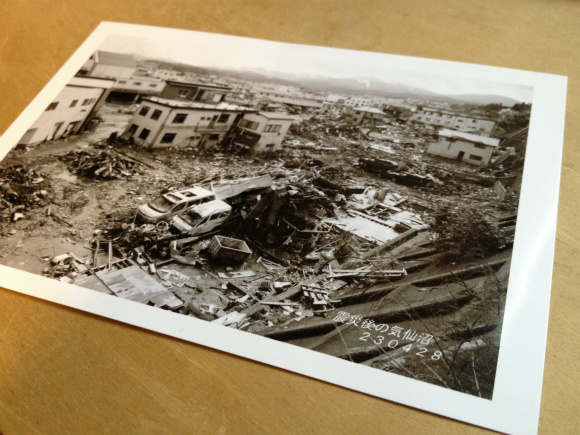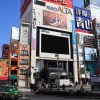
Like with many natural disasters, governments and large corporations throw money and supplies in relief efforts. Although the aid is greatly appreciated and needed by the victims, there is always this lingering cynicism that these donations were done out of self-serving motives. Especially when said company releases an ad tooting their own horn about the contributions they made.
However, a largely unsung gesture by FujiFilm has recently celebrated its milestone of restoring over 1,000,000 photos recovered from earthquake devastated areas. The cynic in you may ask what the big deal is about cleaning some photos when these people need food and shelter.
“The memories the photos give us can’t be bought” explained project leader Yuichi Itabashi. And while that may sound cliché the truth of it hit many volunteer workers like a cold bucket of water.
“I would come across a tattered photo of a laughing baby and look at it wondering; ‘is this baby was still living as happily or.’ I would have to fight back the tears. I kept telling myself to put aside my feelings and focus on my work, but I couldn’t.” one 30 year-old volunteer said.
She was one of the over 1,500 people who volunteered in FujiFilm’s ongoing Photo Relief Project to help rescue people’s memories. In the program any photograph found in the damaged areas is collected, cleaned, and posted in the local community center where the rightful owner can claim it.
While you may have been touched by her testimony, again the cynic in you is probably saying that FujiFilm is just appealing to our sentimentality to boost its own image. But looking into how much effort is involved in this process may change things.
First off to ensure the quality of photo restoration is the highest. The company sent teams to each damaged area to run soil tests. This was done so they could find the bacteria contents of each area’s soil and determine their effects on the colors of the pictures. This information was then used to instruct each volunteer how to best clean each photograph delicately and effectively.
This level of care in volunteer efforts is not unheard of for this company either. A few years ago when Aichi was flooded from heavy rains, FujiFilm rushed to research how best to clean photos that were submerged in salt water. This was after realizing that their previous manual had only explained how to clean photos that were submerged in muddy water.
I imagine the hardest cynics out there still aren’t impressed but whatever FujiFilms motivations are the ends more than justifies the means in this case. To provide photos, in some cases of lost family, to their owners can relieve an emotional burden that in the words of Mr. Itabashi “can’t be bought.”
Source: News Post Seven (Japanese)

 Fujifilm removes promotional video after it causes outrage【Video】
Fujifilm removes promotional video after it causes outrage【Video】 70 Japanese students volunteer to help clean Canada’s shores of Tohoku Tsunami debris
70 Japanese students volunteer to help clean Canada’s shores of Tohoku Tsunami debris Tweeters urge Japanese to donate to Serbian flood relief as repayment for Tōhoku support
Tweeters urge Japanese to donate to Serbian flood relief as repayment for Tōhoku support Netizens annoyed that Japan Self-Defense Forces had to announce that aid workers can use restrooms
Netizens annoyed that Japan Self-Defense Forces had to announce that aid workers can use restrooms Japan’s secret garbage problem–and what you can do to help
Japan’s secret garbage problem–and what you can do to help McDonald’s new Happy Meals offer up cute and practical Sanrio lifestyle goods
McDonald’s new Happy Meals offer up cute and practical Sanrio lifestyle goods All-you-can-drink Starbucks and amazing views part of Tokyo’s new 170 meter-high sky lounge
All-you-can-drink Starbucks and amazing views part of Tokyo’s new 170 meter-high sky lounge Studio Ghibli releases new action figures featuring Nausicaä of the Valley of the Wind characters
Studio Ghibli releases new action figures featuring Nausicaä of the Valley of the Wind characters Kyoto’s 100 Demons yokai monster parade returns!
Kyoto’s 100 Demons yokai monster parade returns! Super Nintendo World expansion gets delayed for several months at Universal Studios Japan
Super Nintendo World expansion gets delayed for several months at Universal Studios Japan The oldest tunnel in Japan is believed to be haunted, and strange things happen when we go there
The oldest tunnel in Japan is believed to be haunted, and strange things happen when we go there The humane (and adorable) way to make a flat hamster 【Video】
The humane (and adorable) way to make a flat hamster 【Video】 Japan’s first-ever capybara cat cafe opens in Tokyo
Japan’s first-ever capybara cat cafe opens in Tokyo Kyoto’s “ikezu” culture of backhanded compliments explained in hilarious souvenir sticker series
Kyoto’s “ikezu” culture of backhanded compliments explained in hilarious souvenir sticker series Muscly Japanese men fill stock photo site with hilarious poses in unusual settings
Muscly Japanese men fill stock photo site with hilarious poses in unusual settings More foreign tourists than ever before in history visited Japan last month
More foreign tourists than ever before in history visited Japan last month Disney princesses get official manga makeovers for Manga Princess Cafe opening in Tokyo
Disney princesses get official manga makeovers for Manga Princess Cafe opening in Tokyo Starbucks reopens at Shibuya Scramble Crossing with new look and design concept
Starbucks reopens at Shibuya Scramble Crossing with new look and design concept Beautiful new Final Fantasy T-shirt collection on the way from Uniqlo【Photos】
Beautiful new Final Fantasy T-shirt collection on the way from Uniqlo【Photos】 Is the new Shinkansen Train Desk ticket worth it?
Is the new Shinkansen Train Desk ticket worth it? Foreign English teachers in Japan pick their favorite Japanese-language phrases【Survey】
Foreign English teachers in Japan pick their favorite Japanese-language phrases【Survey】 Studio Ghibli glasses cases let anime characters keep an eye on your spectacles
Studio Ghibli glasses cases let anime characters keep an eye on your spectacles Beautiful Sailor Moon manhole cover coasters being given out for free by Tokyo tourist center
Beautiful Sailor Moon manhole cover coasters being given out for free by Tokyo tourist center Studio Ghibli releases Kiki’s Delivery Service chocolate cake pouches in Japan
Studio Ghibli releases Kiki’s Delivery Service chocolate cake pouches in Japan Japan’s bone-breaking and record-breaking roller coaster is permanently shutting down
Japan’s bone-breaking and record-breaking roller coaster is permanently shutting down New definition of “Japanese whiskey” goes into effect to prevent fakes from fooling overseas buyers
New definition of “Japanese whiskey” goes into effect to prevent fakes from fooling overseas buyers Our Japanese reporter visits Costco in the U.S., finds super American and very Japanese things
Our Japanese reporter visits Costco in the U.S., finds super American and very Japanese things Studio Ghibli unveils Mother’s Day gift set that captures the love in My Neighbour Totoro
Studio Ghibli unveils Mother’s Day gift set that captures the love in My Neighbour Totoro Domino’s Japan now sells…pizza ears?
Domino’s Japan now sells…pizza ears? New Japanese KitKat flavour stars Sanrio characters, including Hello Kitty
New Japanese KitKat flavour stars Sanrio characters, including Hello Kitty One of Tokyo’s most famous meeting-spot landmarks is closing for good
One of Tokyo’s most famous meeting-spot landmarks is closing for good Kyoto creates new for-tourist buses to address overtourism with higher prices, faster rides
Kyoto creates new for-tourist buses to address overtourism with higher prices, faster rides Sales of Japan’s most convenient train ticket/shopping payment cards suspended indefinitely
Sales of Japan’s most convenient train ticket/shopping payment cards suspended indefinitely Sold-out Studio Ghibli desktop humidifiers are back so Totoro can help you through the dry season
Sold-out Studio Ghibli desktop humidifiers are back so Totoro can help you through the dry season Japanese government to make first change to romanization spelling rules since the 1950s
Japanese government to make first change to romanization spelling rules since the 1950s Ghibli founders Toshio Suzuki and Hayao Miyazaki contribute to Japanese whisky Totoro label design
Ghibli founders Toshio Suzuki and Hayao Miyazaki contribute to Japanese whisky Totoro label design Doraemon found buried at sea as scene from 1993 anime becomes real life【Photos】
Doraemon found buried at sea as scene from 1993 anime becomes real life【Photos】 Tokyo’s most famous Starbucks is closed
Tokyo’s most famous Starbucks is closed One Piece characters’ nationalities revealed, but fans have mixed opinions
One Piece characters’ nationalities revealed, but fans have mixed opinions We asked a Uniqlo employee what four things we should buy and their suggestions didn’t disappoint
We asked a Uniqlo employee what four things we should buy and their suggestions didn’t disappoint Princesses, fruits, and blacksmiths: Study reveals the 30 most unusual family names in Japan
Princesses, fruits, and blacksmiths: Study reveals the 30 most unusual family names in Japan Volunteers cleaned up 45 tons of garbage from Manila Bay beach, restored it to its former glory
Volunteers cleaned up 45 tons of garbage from Manila Bay beach, restored it to its former glory Spirit of volunteering strong for Tokyo 2020 Olympics, but data suggests something may be off
Spirit of volunteering strong for Tokyo 2020 Olympics, but data suggests something may be off Japanese government plans removal of around 2,485 miles’ worth of overhead power lines
Japanese government plans removal of around 2,485 miles’ worth of overhead power lines Tohoku tsunami survivor’s $12K camera: heart-felt gift or PR stunt?
Tohoku tsunami survivor’s $12K camera: heart-felt gift or PR stunt? China’s most pompous millionaire just threw a ridiculously fancy lunch for homeless New Yorkers
China’s most pompous millionaire just threw a ridiculously fancy lunch for homeless New Yorkers Victim of 3.11 to people who have never suffered a disaster: Don’t send origami cranes to shelters
Victim of 3.11 to people who have never suffered a disaster: Don’t send origami cranes to shelters Singapore’s Home for Hope Campaign finds homes for shelter dogs…at IKEA!
Singapore’s Home for Hope Campaign finds homes for shelter dogs…at IKEA! Idols from the sea! Massive haul of idol singer photos wash up on Japanese coast【Photos】
Idols from the sea! Massive haul of idol singer photos wash up on Japanese coast【Photos】 Online seller sends special surprise to Kumamoto earthquake survivor
Online seller sends special surprise to Kumamoto earthquake survivor Tokyo schoolgirls invent eco and cost-friendly portable toilet for disaster relief【Video】
Tokyo schoolgirls invent eco and cost-friendly portable toilet for disaster relief【Video】 Nintendo’s god-tier customer service continues as they offer free repairs for Noto earthquake victims
Nintendo’s god-tier customer service continues as they offer free repairs for Noto earthquake victims Messages of support from Taiwan warm the hearts of Kumamoto earthquake victims
Messages of support from Taiwan warm the hearts of Kumamoto earthquake victims Why does it take so long for Japanese trains to start running again after an accident?
Why does it take so long for Japanese trains to start running again after an accident? New baby-themed haunted house in Tokyo says there’s nothing to be afraid of, is totally lying
New baby-themed haunted house in Tokyo says there’s nothing to be afraid of, is totally lying Japanese man arrested for putting semen-filled condoms in schoolgirls’ bags for several years
Japanese man arrested for putting semen-filled condoms in schoolgirls’ bags for several years Selfie love shown between South and North Korean gymnasts
Selfie love shown between South and North Korean gymnasts
Leave a Reply